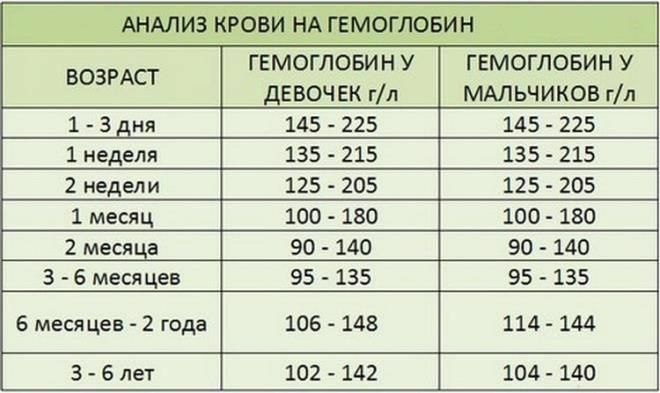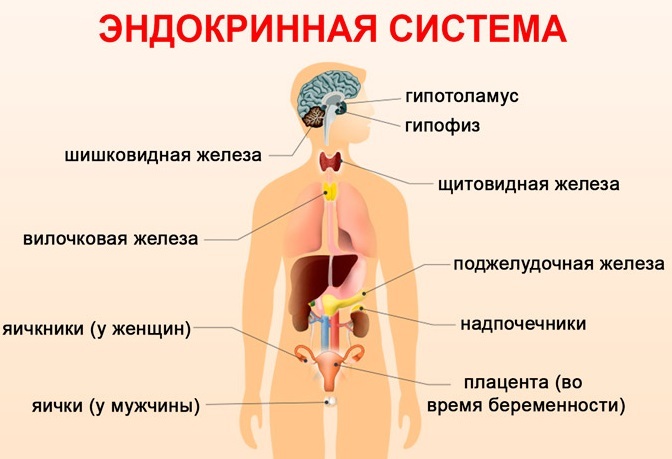Content
- Attachment concept in psychology
- Formation of attachment
- Attachment types and signs
- Emotional
- Affective
- Ambivalent
- Symbiotic
- Sexy
- Avoidance type
- Neurotic
- Disorganized
- Varieties of state
- Reliable
- Remote
- Anxious
- Neurotic
- How to recognize?
- Strong attraction
- Increased anxiety
- Dependence on a partner
- How to distinguish love from affection?
- How to get rid of attachment?
- Can the type of attachment be changed?
- What are the problems with attachment?
- Consequences
- Attachment videos
Affection is capable of varying degrees experience all people, even those who, for whatever reason, deny it. Most psychologists believe that the concept of attachment is multifaceted and includes a whole spectrum various states and emotional sensations: interest, falling in love, feeling of closeness, dedication, loyalty.
Affection is not always a positive and harmonious feeling. In some cases, people can experience painful attachment, which negatively and destructively affects both their own life and the life of the object of their adoration.
Attachment concept in psychology
Attachment in psychology is a special relationship of one person to another, based on deep sympathy, love, interest. Affection arises in love, friendship, kinship, parent-child relationships.

In society, the phenomenon of attachment is usually associated with something positive and positive, since it is generally accepted that this feeling leads to the emergence and development of good and wonderful intentions and emotions. This undoubtedly happens if the relationship is initially healthy and the feeling of affection that arises is sincere. and mutual, for example, in a harmonious couple in love, with parents in relation to their long-awaited and beloved baby, and he has to them.
However, sometimes attachment can be painful, destructive. This happens when one person in a pair becomes strongly attached to another and, for example, does not want to accept the emerging in the event of a crisis the need to terminate the relationship, begins to harass and harass his partner with jealousy, claiming that he cannot without him live.
This behavior is not only found in love relationships, it can also be observed in families where the mother is emotionally cold towards her children. and they are attached to it, or in adult infantile children, painfully attached to their parental family and do not want to leave it and live on one's own.
Formation of attachment
Attachment in psychology is a feeling of closeness based on sympathy, devotion, or falling in love. Initially, each child develops attachment to his mother, and later to other people who are involved in his upbringing.
The emergence of feelings of attachment is due to genetic, innate mechanisms. English psychiatrist and psychoanalyst John Bololby has identified a particular relevance to mental health the child has a warm attitude towards him by the mother and the formation of a response in him - affection. He was the first researcher to link the successful adaptation and survival of a child with the development of this very feeling in him.
The fundamental principle of this theory is that for normal spiritual and social development children in their life must be present at least one adult with whom they will have a close contact. The main factor in the successful mental development of a child is the sufficient presence in his life of the mother, who gives him a sense of security.
At the same time, when raising children, it is important for mothers to maintain a balance, since with excessive care of the baby, over time, the society of the mother can begin to weigh on, so women should of a certain age, gradually letting children go from themselves, making them feel like separate individuals (occasionally leaving them with relatives for a short time, on time socialize). With indifferent behavior of the mother, the child will grow up restless and anxious.
Attachment types and signs
All attachments can be conditionally divided into several types, each of which has its own distinctive features. With the formation of attachment in childhood, psychologists directly link which of its types will prevail in adult life in a person when building loving and friendly relationships.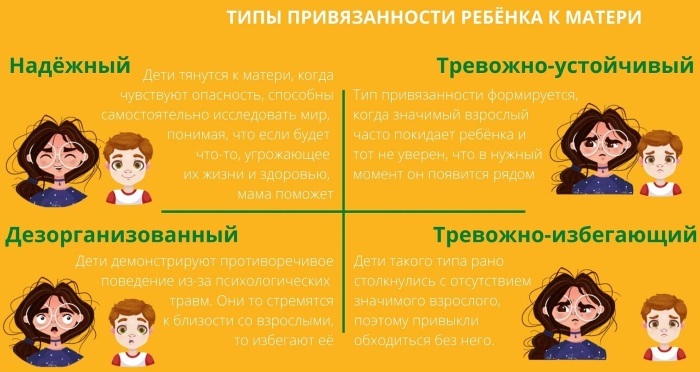
In addition to the experience gained in early childhood, the dominance of a particular type of attachment is also significantly influenced by the temperament of the person himself.
Emotional
To a greater extent, it is characteristic of love erotic relationships, which are based not only on sex, but also on emotional interconnection. The main sign of such affection is deep, sincere feelings. If a couple develops a romantic relationship, where there is both passion and emotional closeness, their attachment to each other is formed faster.
This type of attachment is not a bad foundation for the development of further relationships, creating a family. However, this applies only to those couples who really develop harmonious relationships built on mutual respect and trust. If there is some destructive component in the relationship (jealousy, aggression of one of the partners), then a vicious circle is created when, due to attachment, it is difficult to break this connection.
Affective
Psychologists attribute this type of attachment to neurotic disorders, since with it the child is usually too much attached to his mother, but at the same time behaves somewhat strangely. Children with an affective type of attachment find it difficult to bear even a small separation from their mother, but even when it reappears, they calm down. only for a short time and can scream, behave aggressively, expressing their resentment for being abandoned and worrying that the situation may repeat.
Ambivalent
Ambivalence literally means duality in relation to something, when the same event or object causes 2 opposite reactions in a person.
Usually, ambivalent or dual attachment occurs in children who experienced acute "emotional hunger" in childhood and adolescence. As a result of such upbringing, they do not receive the necessary amount of affection and love and try to compensate for this by becoming attached to completely strangers.
It is noteworthy that this tendency persists throughout life and the child, becoming an adult and building his own life and relationships, always tries to take this love that was not received in childhood from someone who is included in his nearest environment.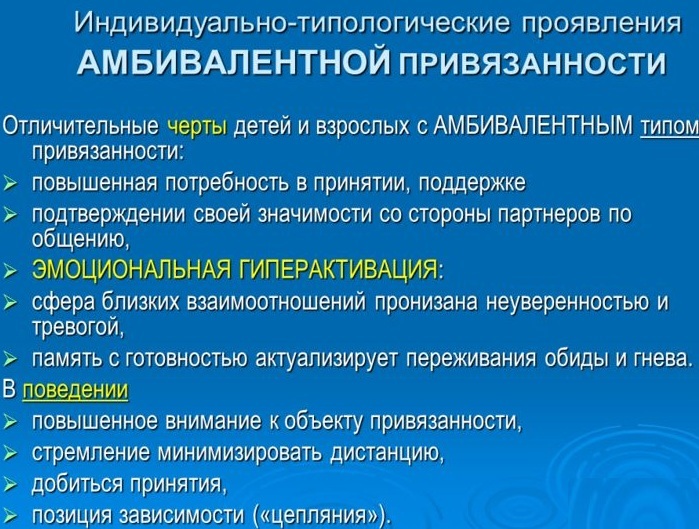
The main sign of this type of attachment is excessive gullibility, which is characteristic not only of children, but also of adults. For this reason, both one and the other often become easy prey for dishonest people.
Other signs of an ambivalent attachment type include:
- anxiety;
- hyperactivity;
- desire to control everyone around;
- lack of self-confidence;
- "Emotional swing" - the attitude towards the same person can change several times during the day.
Symbiotic
Symbiotic attachment occurs in children from birth to a certain age (before the crisis of 3 years) and is absolutely normal. Thanks to symbiosis with the mother, close bodily and emotional contact, the baby is not only able to survive, but also has all the prerequisites to develop harmoniously and in a timely manner. Abandoned children, who receive only basic care in orphanages and do not know the love of their mother, are deprived of this connection.
Upon reaching 3 years of age, most healthy children go through a kind of separation crisis, when they are already fully aware that they are not one with their mother and strive to independence. If at this stage the mother begins to overly worry and worry about the child, then this can harm both him and her.
The woman herself will experience feelings such as:
- exhaustion;
- fatigue;
- impotence;
- irritation;
- anger.
At the same time, the child also does not behave in the best way, demonstrating that he cannot do without his mother. Such a violation of separation leads to the fact that he will feel a painful symbiotic attachment for a long time. and a strong desire to merge with another significant person (first with the mother, then completely dominating him partner).
Most often, this type of attachment develops in children in cases where their mother herself, when she was a child, went through this childhood crisis stage with the same difficulties, and she was not perceived as a separate, albeit small, personality.
Sexy
Due to the psychological and hormonal characteristics of the fair sex, attachment to their intimate partner manifests itself more strongly in them than in men. During sex, women produce a lot of oxytocin (it is also produced during childbirth), which is responsible for the formation of feelings of attachment.
This effect enhances the effect of another female hormone - estrogen, which has a calming effect on women and increases sympathy for the chosen partner. In addition, women, due to the peculiarities of their psyche, are more emotional, sensitive and amorous, which also contributes to a quick addiction to the chosen one.
Unlike women, men produce a lot of testosterone during intercourse, which, on the contrary, suppresses nascent emotions associated with affection and falling in love, which explains the easy-thinking behavior of some of them. Women, on the other hand, can become very attached to a partner after the first close intimate meeting, which rarely happens with men.
A breakup is more painful for a woman, since her sex life is directly related to her feelings and affection for her chosen one. Men can become attached to their partners, but this does not happen immediately, but gradually, as they get used to and get to know each other.
Avoidance type
Avoidant attachment occurs in children and is considered a variant of disrupting the normal relationship with the mother. The main sign of this type of attachment is the child's complete indifference to the mother. Visually, it looks like he doesn't care if his mother is with him or not. These children do not cry or scream when their mother falls out of their field of vision and calmly make contact with other, even strangers, people.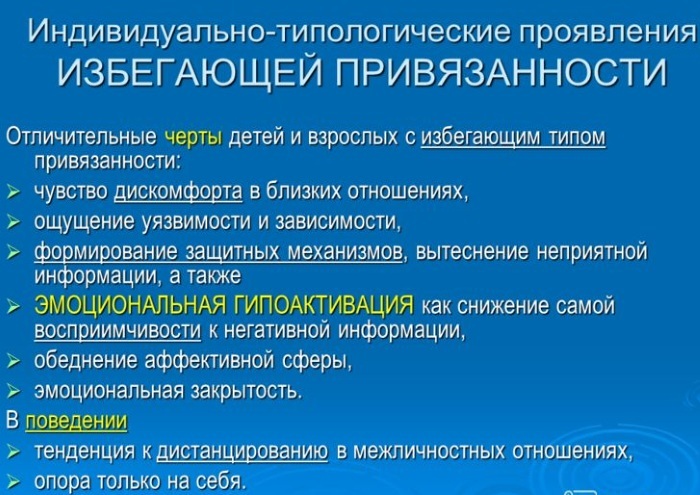
The prerequisites for developing this type of attachment are:
- separation from mother;
- social deprivation (when the ability to stay in society is lost or not initially formed).
Such a child, having matured, faces a number of difficulties in life:
- does not know how and does not know how to ask for help, support;
- prefers not to be touched by anyone;
- has no attachment to relatives;
- unable to maintain a long-term relationship;
- prefers to be alone.
Neurotic
It takes place in both children and adults. In children, neurotic attachment is expressed in the fact that they demand that the mother is always with them. In order to achieve this, they throw tantrums and manipulate their mother, as well as other adults who always feel sorry for the child and shame the mother if she decided to show character and rebuff his obsession, since it is more convenient and easier for them to get a woman to deal with this problem than to help her deal with situation.
If this behavior is not corrected, then in the end the child, as he grows up, will still demonstrates extreme affection for his mother and already knows how to perfectly play on his suffering and achieve his own.
In adults, neurotic attachment is observed in difficult love relationships when someone from partners behaves too selfishly and wants the other to belong only to him alone completely and fully. At the same time, for the person suffering from neurotic attachment, the circle of interests narrows to the circle of interests of his companion, which becomes his life meaning.
Getting into such dependence, he begins to demand from the chosen one similar manifestations and proofs of his love and attachment - refusal of any communication, including with relatives, their interests, possibly labor activities. Being in this state, the neurotic partner constantly feels discomfort and worries about the relationship, is jealous and controls his other half.
Disorganized
Disorganized attachment is characterized by the fact that children do not know how to control their emotions and impulses. The formation of this type of attachment is associated with problems in the family, when it was normal for parents to use violence and abuse against their children.
Signs of disorganized attachment include:
- inability to empathize with other people;
- undeveloped, poor speech;
- inability to build long-term connections and relationships;
- inability to understand people (strangers are more credible than relatives);
- consumer attitude towards supportive people.

Growing up children with a disorganized type of attachment, often commit criminal offenses, can cause physical harm to themselves and others.
Varieties of state
Attachment in psychology is a special allocation of one person to another, with whom, as a rule, he is connected by a close emotional relationship, friendly or love relationship.
Depending on whether the attachment is sick or healthy, the following varieties are distinguished:
- reliable;
- remote;
- anxious;
- neurotic.
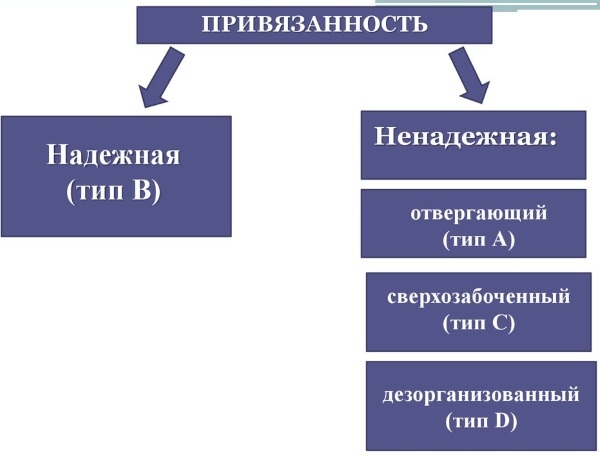
If attachment is sick, then the relationship will bring pain and suffering and become excruciating for each party. Healthy attachments can usually calmly fade away when the relationship fades and the partners separate. In this situation, they do not pursue each other, but continue each of their life paths separately and gradually wean themselves from each other. Otherwise, attachment can turn into a severe form of addiction, which is very difficult to get rid of.
Reliable
A reliable type of attachment refers to a healthy form of addiction to someone, as it initially appears as a result of the manifestation of care, love, attention. Such a connection is formed in children from a very early age if they grow up in love and harmony and the mother devotes herself to the child in due measure.
In adulthood, a mature mutual affection is formed between a man and a woman who are in a love relationship. Attachment to a loved one is expressed in the fact that each of the partners has deep feelings for the other, but at the same time calmly accepts his temporary absence. If a crisis occurs in a relationship, then people with a reliable type of attachment know how to negotiate and disperse peacefully, without subsequent persecution and manipulation of each other.
Remote
If people are strongly attached to each other, then even short-term separation can make them feel lonely, bored and empty. This is completely normal. It will not be normal to behave in which one of the partners begins to panic and thinks that he will not survive without his chosen one even for a small amount of time. A person with a painful distant attachment may behave compulsively, speculate in his helplessness, cannot live normally and perform routine duties.
Anxious
Anxious attachment is divided into 2 forms: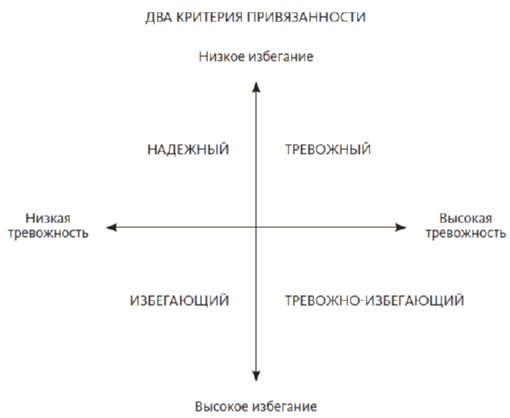
| Anxious-avoidant | When a person loses the object of adoration, then he experiences discomfort, which he does not particularly hide. |
| Anxiety-resistant | In this case, emotional coldness manifests itself, when a person does not show in any way that he needs in the one to whom he is so strongly attached, and subsequently, even when meeting with him, behaves detached. This type of attachment is often formed in children whom the mother left for some reason and then returned. |
Neurotic
The neurotic form of attachment is considered by psychologists and psychiatrists as a pathological disorder. In children, this dependence is manifested in the fact that they cannot let go of their mother even a step, when they are no longer too small. In adults, neurotic attachment is most often characteristic of unhealthy love relationships, when one of the partners is overly jealous, suspicious and a terrible possessive.
In order to keep your other half from breaking off relations, a person with a neurotic form attachment goes to tricks: manipulates children, joint property, threatens that he will end yourself. It is very difficult to get rid of this kind of addiction on your own, without the help of relatives and specialists.
How to recognize?
Attachment is a state in which one person is attracted to another and wants to spend his time with him, see him as often as possible. In psychology, it is customary to single out healthy and sick attachment, which can poison the life of both the addicted person himself and his partner, to whom all impulses and claims are addressed.
Strong attraction
It is characterized by the fact that a person experiences an excessively strong attraction and attraction to another, is ready for anything to be with him. Such people endure humiliation, insults and close their eyes even to the serious flaws of their life partners.
Often they try to limit the freedom of the chosen one in all conceivable and inconceivable ways, sometimes forbidding them to contact anyone at all, including colleagues and close relatives. A break in a relationship can seriously affect the psyche of such a person and often leads to depression.
Increased anxiety
It often manifests itself in insecure, notorious people who think that if a partner is not around, then he will definitely use this free time to meet with other people, cheating. They constantly think that the chosen one is behaving somehow strangely, has cooled off and is trying to avoid their company. Constantly emerging, these emotions lead to the development of nervousness, depression.
Dependence on a partner
Initially, all relationships between a man and a woman are codependent, since each in a pair gives something, but receives something in return. If this balance is violated and one of the partners does not receive anything, and the other selfishly uses the weaknesses of the lover the chosen one, then the first person may gradually develop an unhealthy dependence on a partner if he roads.
It seems to him that he cannot live without his other half and therefore endures all the antics, humiliation, while trying to please, thinking that in this way he can improve relations and win love. However, in the end, the tension only grows, since the not conscientious and indifferent partner begins to allow himself more and more with each time forcing the addict who loves him to suffer more, simply by using them.
How to distinguish love from affection?
Especially often this question is asked by women who, due to their greater natural emotionality, cannot always understand whether they love a partner or are simply strongly attached to him.
The main differences between these 2 senses are:
- with affection, a person feels a strong attraction, and when he loves, he feels a kinship of souls;
- love is a constant and deep feeling, with attachment, feelings can periodically subside and flare up with renewed vigor;
- love gives a person the strength to move on and develop, while attachment causes melancholy feelings;
- getting attached, a person, first of all, thinks about himself and is driven by his own egoism, although he may not count and not be aware of this. When a person sincerely loves, he accepts a partner as he is and does not seek to remake him, restrict freedom and prohibit something.
How to get rid of attachment?
Affection in psychology is a connection between people based on mutual sympathy, love, common interests. If attachment takes on a pathological character and becomes a deviation, then it can significantly interfere with both the addicted person himself and another individual who is in connection with him.
In some cases, you can get rid of attachment only by seeking help from a specialist psychologist (neurotic, anxious attachment). In situations where the desire to be with another person has not yet acquired a manic character, you can try to cope with the addiction on your own.
To do this, you need to answer yourself honestly to the following questions:
- what happens if communication with this person is interrupted;
- what is the real reason for the emerging fear of losing this relationship;
- why there is a feeling that it is impossible to live fully, normally and happily without a partner;
- what the relationship really is based on.
Very often it turns out that a person simply gets used to receiving happiness or believes that he gets it by being close to another. However, it is important to learn to be self-sufficient and happy regardless of opinion and presence. partner, especially if the relationship has become toxic, has long outlived its usefulness and keep on only one affection.
Can the type of attachment be changed?
Scientists and psychologists tend to believe that the type of attachment is more influenced by genetic factors, as well as the experience of relationships with parents or their substitutes, received in early childhood. Subsequently, it is quite difficult to change the embedded information and, as studies show, in 70-80% of people, the type of attachment does not change throughout their lives.
On the other hand, some experts believe that attachment is just a built-in habit and can and should be worked with, especially if it is destructive.
What are the problems with attachment?
As discussed above, over-attachment negatively affects relationships. The resulting jealousy, disagreements and misunderstandings do not in any way contribute to the creation of a strong family and the upbringing of children with a stable and healthy psyche in it.
The unformed attachment that is observed in abandoned children leads to the fact that in an adult life, such people cannot create their own families and often lead a lost, asocial image life.
Sometimes absolute normal attachment creates problems when a person does not find reciprocal feelings from a partner. In this situation, he may feel sadness, annoyance, disappointment, but he will not pursue another person in order to tie him to himself. On the contrary, he will try to distract himself and extinguish feelings as quickly as possible, and not impose on the chosen one who refused him.
Consequences
Normal healthy attachment promotes rapid social adaptation. If a person knows how to make friends, is open to communication and relationships, but at the same time can easily refuse object of desire in the absence of reciprocal sympathy, then it will not be difficult for her to happily build her own a life.
With pathological attachment, many things in relationships with other people are perceived distorted. A person begins to live in illusions, perceives the situation inadequately, begins to impose on other people and is disappointed in them if they do not reciprocate. It is difficult to build relationships with such people and therefore they are often unhappy.
Affection is the most important feeling for a person, determining the degree of his intimacy with someone. Psychologists believe that the initially formed attachment to the mother largely determines how a person will build his relationship in the future.
People who are prone to pathological obsessive attachment, as well as those who are not particularly attached to anyone, equally experience difficulties in friendships, close and family relationships. These states do not allow a person to feel happy, they should be worked out and corrected with a psychologist.
Attachment videos
Attachment psychology:

